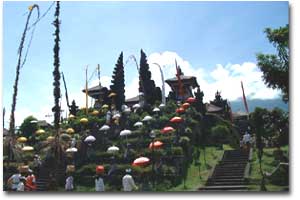| Religion
and Custom
 Hindu
religion or Hindu Dharma is held by almost 95% of the population.
Its teaching is to reach peace and harmony in life guided
by the Wedas as Holy Scriptures. Hindu Dharma is a special
blend of Hinduism, Buddhism and ancestor worship that has
been flourishing over the centuries. They believe in One Supreme
God called Ida Sang Hyang Widhi Wasa, with His three manifestations
known as Trisakti, that is Brahma The Creator, Wisnu The Preserver,
and Shiwa The Transformer. Hindu
religion or Hindu Dharma is held by almost 95% of the population.
Its teaching is to reach peace and harmony in life guided
by the Wedas as Holy Scriptures. Hindu Dharma is a special
blend of Hinduism, Buddhism and ancestor worship that has
been flourishing over the centuries. They believe in One Supreme
God called Ida Sang Hyang Widhi Wasa, with His three manifestations
known as Trisakti, that is Brahma The Creator, Wisnu The Preserver,
and Shiwa The Transformer.
Indian
philosophy provides the theological framework while indigenous
beliefs are at the core of the rituals. Such blending of beliefs
is legitimate in Bali where the saying goes as follows, "The
truth is one, the interpretations multiple".
Indigenous beliefs are clearly seen in the belief of natural
elements and of the ancestors. Nature is viewed as "power"
itself and each of its elements is thought to be subjected
to spirits. These must be taken care of, provided with a shrine,
fed with various offerings made from agricultural products
and given respect.
The mother mountain, Gunung Agung, is highly sacred to the
Balinese and central to their beliefs. It is the abode of
the gods and the ancestors and where you return to when you
die.
Religion in Bali varies according to three principles; desa
(place), kala (time), and patra (circumstances). Hinduism
acknowledges five pillars of faith, respectively; belief in
the one Supreme God (Sang Hyang Widhi Wasa), belief in the
soul as the universal principle of life and consciousness
(atma), the belief in the fruition of one's deeds (karma phala),
belief in the process of birth and death (samsara) and belief
in ultimate release (moksa). One of the consequences of the
principle of karma and samsara is the existence of the wangsa
system where an individual inherits his status as a result
of his or past life. The four wangsa in Bali are the Brahmana,
who deal with religion and the holy texts, the Satria or rulers,
the Wesia or merchants and the Sudras, the lower class.
Man should endeavour to maintain the harmony of the whole
system, hence the role of rituals. Only by adhering to the
peoples rules of behaviour can the proper balance be kept
between the two sets of godly and demonic forces. Balinese
religion is known to the world through the richness and the
life of the Balinese is therefore replete with rituals.
As the tools for maintaining the balance of the world, there
are rituals for everything imaginable; from knowledge, cleansing
machines to marriage and birth ceremonies, all of different
types and levels. Rituals consists of calling down the gods
and the ancestors for visits from their heavenly abode in
the country above the mountain. They come down during temple
festivals and are entertained with dances and fed with offerings.
They can also be called down through the entreaties of a priest.
Balinese rituals are ruled by a complex calendar system, a
combination of the India
Temples in Bali are simple walled open yards from which people
can communicate directly with their gods and ancestors. Gods
and ancestors normally "visit" their human worshipers
or descendants during temple festivals (odalan). They reside
in miniature houses set in the temple, the pelinggih shrines.
There are few societies in the world where religion plays
a rule such as it does in Bali. The incredible beauty and
colour that accompanies the rituals and offerings, which seem
to be ever occurring, is proof that Bali is continually harmonizing
the world of man with the cosmic world of the Gods.
The strength of their religion and traditions may be the main
factor that enables them to preserve their culture from the
outside influences. Everyday life in Bali merges with social
duties and religious obligations while the art reflects an
unnoticed integration of environment, religion and community
in which the individual is a part. The organization of the
villages, land cultivation's and the creation of art are of
communal efforts. A village in Bali is the central place for
its people while a family is the basic unit of the Balinese
society which is grouped into 'Banjar', the group unit of
several families. (Taken from Indonesia Bali Guide Book, 1997,
p.64-65)
|



